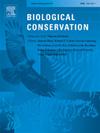Prevalence of endangered shark trophies in automated detection of the online wildlife trade
IF 4.9
1区 环境科学与生态学
Q1 BIODIVERSITY CONSERVATION
引用次数: 0
Abstract
Direct exploitation, which includes the trade of wild animals for their parts, is a major driver of extinction. Digital communication tools, particularly the internet, have facilitated the trade in endangered species. Here, we automatically collected data to analyze online sales of threatened animals across 148 English-text online marketplaces. We created a tool that searched for online sales of 13,267 animal species at risk of global extinction, as classified by the International Union for Conservation of Nature (IUCN), as well as 706 animal species on Appendix I of the Convention for International Trade in Endangered Species (CITES), for which international commercial trade is prohibited. Examining a period of 15 weeks in 2018, we identified 10,699 unique listings selling body parts or eggs of threatened species, of which 4131 contained a full species name (common or scientific). These 4131 results were then filtered by keywords and, finally, manually vetted, which yielded 546 sale listings for 83 species. Of these 546 listings, 61 % advertised shark trophies (mainly jaws), 73 % of which were taken from species listed as endangered or critically endangered. Just four websites hosted >95 % of listings. We identified 18 species for sale that are included on CITES Appendix I. We also identified 13 species for which the IUCN had not identified intentional use as a threat. This work expands current understanding about the dealing of endangered and potentially illegal species online, specifies taxa threatened by online trade, and highlights emerging opportunities and persistent challenges to preventing the trafficking of threatened species.
求助全文
约1分钟内获得全文
求助全文
来源期刊

Biological Conservation
环境科学-环境科学
CiteScore
10.20
自引率
3.40%
发文量
295
审稿时长
61 days
期刊介绍:
Biological Conservation is an international leading journal in the discipline of conservation biology. The journal publishes articles spanning a diverse range of fields that contribute to the biological, sociological, and economic dimensions of conservation and natural resource management. The primary aim of Biological Conservation is the publication of high-quality papers that advance the science and practice of conservation, or which demonstrate the application of conservation principles for natural resource management and policy. Therefore it will be of interest to a broad international readership.
 求助内容:
求助内容: 应助结果提醒方式:
应助结果提醒方式:


